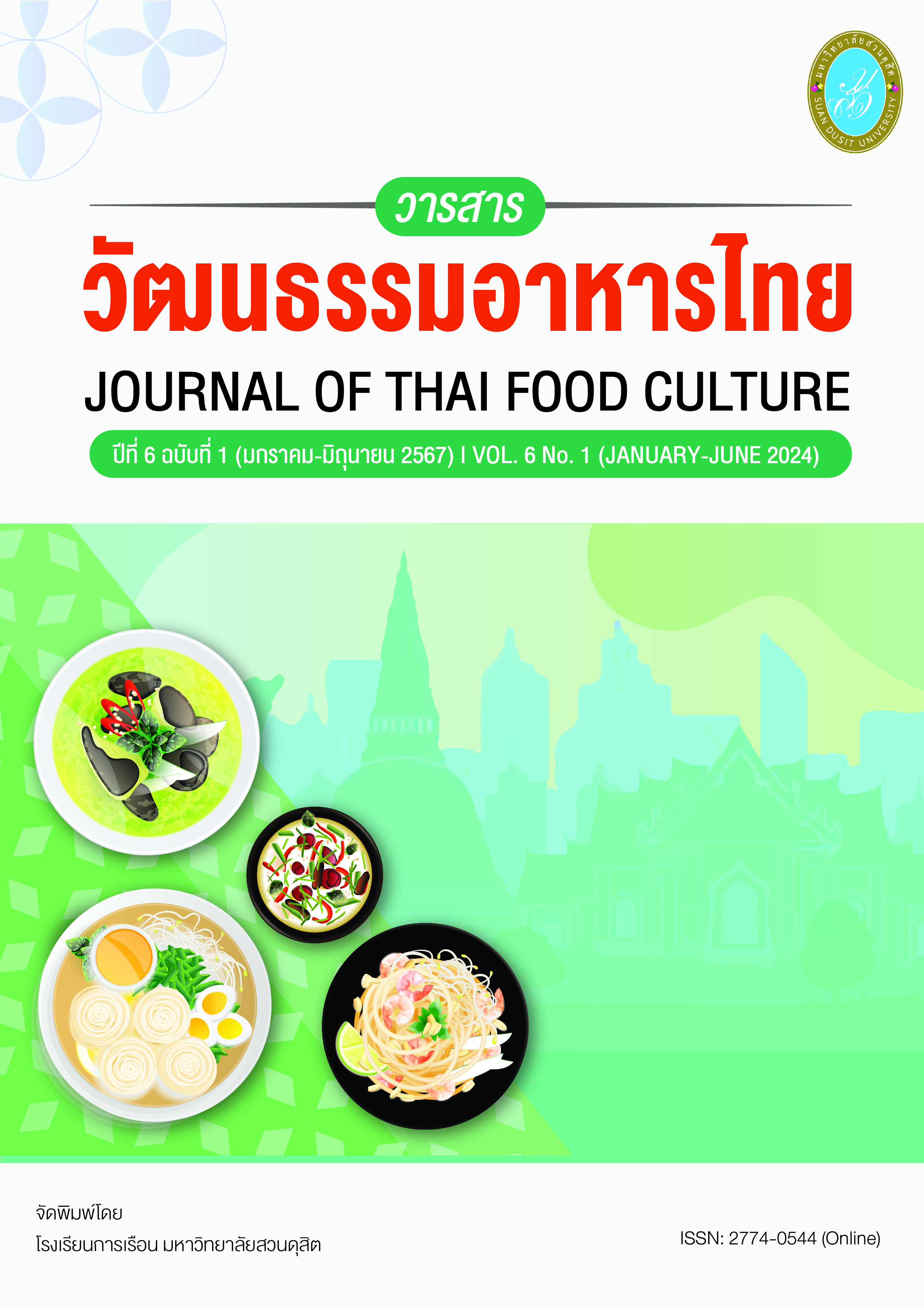Development of five color beans tempeh Chilli Paste recipes
Keywords:
Tempeh, Chilli Paste, Five color beansAbstract
The objectives of this research are to develop a chili paste recipe from five-colored bean tempeh and to evaluate consumer sensory acceptance of the developed chili paste from five-colored bean tempeh recipe. Chili paste is considered to be the most unique food culture of Thailand and diversity in each region especially in the central region, there are many types of chili paste. The raw materials used in the production of chili paste are mostly similar, namely chili, shallots, garlic, galangal, lemongrass, with a mixture of proteins such as dried shrimp and dried fish. Currently, alternative proteins It has rapidly increased in popularity due to consumer behavior and popularity. Important and popular alternative protein sources include protein from legumes. It is cheaper than meat. Tempeh is an Indonesian fermented soybean that is high in protein. It is another source of alternative protein. Tempeh is a fermentation of beans with the fungus Rhizopus oligosporus. Therefore, it is considered a fermented food with high nutritional value, rich in protein, fat, dietary fiber, vitamins, minerals. This study is therefore interested to develop healthy food recipes of chili paste recipe from 5-colored bean tempeh from soybeans, mung beans, red beans, black beans, and white beans. The study found that chili paste recipes tempeh 5 color beans 100 g recipe gave the highest carbohydrate, dietary fiber and vitamin B12 content of 45.51 g, 4.61 g and 0.37 mcg, respectively, while the lowest fat content was 6.37 g. It was found that chili paste recipes tempeh 5 color beans received overall preference scores. There was no statistically significant difference (p>0.05), indicating that the tempeh substitution formula with 5 color beans seems to be a good choice for health-conscious consumers.
References
กฤติกา บูรณโชคไพศาล. (2555). การพัฒนาผลิตภัณฑ์อาหารเส้นจากแป้งถั่วเขียวเพาะงอก. ราชภัฎเพชรบูรณ์สาร, 15(2), 9-15.
นภา โล่ทอง. (2535). กล้าเชื้ออาหารหมักและเทคโนโลยีการผลิต. กรุงเทพฯ: ภาควิชาจุลชีววิทยาคณะวิทยาศาสตร์มหาวิทยาลัยเกษตรศาสตร์.
บริษัท ศูนย์วิจัยกสิกรไทย จํากัด. (2565), กระแสทรรศน์ ฉบับที่ 3333. สืบค้น 3 กันยายน 2565, เข้าถึงได้จาก https://www.kasikornresearch.com/th/analysis/k-econ/business/Pages/Plant-Basez3333.aspx.
บุศรินทร์ จงเจริญยานนท์. (2559). คุณสมบัติเชิงหน้าที่ของ ถั่วขาวและการประยุกต์แป้งถั่วขาวในผลิตภัณฑ์ขนมอบ. วารสารเทคโนโลยีการอาหาร มหาวิทยาลัยสยาม. ;11(1):1-12.
พรดรัล จุลกัลป์ และธนพล กิจพจน์. (2556). การผลิตเทมเป้ถั่วเหลืองด้วยผลกล้าเชื้อ Rhizopus oligosporus TISTR 3098 ในระดับห้องปฏิบัติการ. Rajabhat. J. SCi. Humanit. Soc. SCi. 14(1), 32-41.
พรดรัล จุลกัลป์ และปิยาภรณ์ เชื่อมชัยตระกูล. (2017). การผลิตเทมเป้ถั่วเหลืองด้วยผงเชื้อ RHIZOPUS OLIGOSPORUS TISTR 3089 ในระดับครัวเรือนและการนำไปใช้ทดแทนเนื้อสัตว์ในผงปรุงรส. Rajabhat J. Sci. Humanit. Soc. Sci. 18(1): 201-208.
เพ็ญขวัญ ชมปรีดา. (2536). การประเมินคุณภาพทางประสาทสัมผัส. ภาควิชาพัฒนาผลิตภัณฑ์. คณะอุตสาหกรรมเกษตร. มหาวิทยาลัยเกษตรศาสตร์. กรุงเทพมหานคร.
ไพโรจน์ วิริยจารี. (2545). การประเมินทางประสาทสัมผัส (Sensory Evaluation). พิมพ์ครั้งที่ 2. เชียงใหม่ : คณะ อุตสาหกรมเกษตร มหาวิทยาลัยเชียงใหม่.
มาฤดี ผ่องพิพัฒน์พงศ์, อำนาจ คูตะคุ, ดวงจันทร์ เฮงสวัสดิ์, กรุณา วงษ์กระจ่าง, ชมดาว สิกขะมณฑล. (2556). การผลิตอาหารเพื่อสุขภาพจากถั่ว 5 สีสำหรับผู้สูงวัยด้วยกรรมวิธีเอ็กซ์ทรูชัน. การประชุมวิชาการ สมาคมวิศวกรรมเกษตรแห่งประเทศไทย ระดับชาติ ครั้งที่ 14 และระดับนานาชาติ ครั้งที่ 6; มหาวิทยาลัยราชมงคลธัญบุรี. ปทุมธานี.
วราวุฒิ ครูส่ง และรุ่งนภา พงสวัสดิ์มานิต. (2532). เทคโนโลยีการหมักในอุตสาหกรรม. โอ.เอส.พริ้นติ้งเฮ้าส์, กรุงเทพฯ.
สิริมนต์ ชายเกตุ, ศาลินา วงษ์ไทย, อรุษา เชาวนลิขิต, อุลิสาณ์ พาชีครีพาพล, ชาติรส การะเวก, และสมชาย สุริยะศิริบุตร. (2010). การบริโภคน้ำพริกของผู้บริโภคในกรุงเทพมหานคร (CHILLI PASTE CONSUMPTION AMONG CONSUMERS IN BANGKOK METROPOLITAN). Journal of Srinakharinwirot University (Journal of Science and Technology), 2(3), 64-79.
สุจินดา สุวรรณกิจ (2534). การผลิตถั่วเหลืองหมักถั่วลิสงค์ ระดับอุตสาหกรรมในครัวเรือน. วิทยานิพนธ์ปริญญาโท. กรุงเทพฯ: มหาวิทยาลัยเกษตรศาสตร์.
Cempaka, L., Eliza, N., Ardiansyah, A., Handoko, D.D., & Astuti, R.M. (2018). Proximate Composition, Total Phenolic Content, and Sensory Analysis of Rice Bran Tempeh. Makara Journal of Science, 22(2), 89-94.
Chen, K.I., Erh, M.H., Su, N.W. & Cheng, K.C. (2012). Soy foods and soybean products : from traditional use to modern applications. Appl Microbiol Biotechnol, 96, 9-22.
Hexa Research. (2019). Tempeh Market Size and Forecast, By Product Type (Conventional, Organic), By Distribution Channel (Offline, Online), By Region (North America, Europe, Asia Pacific, Rest of the World) And Trend Analysis, 2019 – 2025. Retrieved September 3, 2022, from https://www.hexaresearch.com.
Iqbal, A., Khalil, I. A., Ateeq, N. & Muhammad Sayyar Khan (2006). Nutritional quality of important food legumes. Food Chemistry, 97(2), 331-335.
Ogawa, Y., Tokumasu, S. & Tubaki, K. (2004). An original habitat of tempeh molds. Mycoscience, 45(4), 45, 271-276.
Okada, Noriyuki, Ratna Siri Hadioetomo, & Sayuki Niekuni.. (1983). Vitamin B12 content of fermented foods in the tropics. Report of National Food Research Institute, 43, 126-129.
Seng, K. (1998). Development of Tempeh Based Snack Food. Retrieved April 13, 2022, from http://www.nre.vic.gov.au/TRADE/ ASIAVEG/nlaf_02.
Srapinkornburee, W., Tassanaudom, U. & Nipornram, S. (2009). “Commercial development of red kidney bean tempeh.” Asian journal of Food and Agrolndustry. 2(3), 362-372.
Salvador Tranche, Carlos Brotons, Beatriz Pascual de la Pisa, Ramón Macías, Eduardo Hevia, & Mercè Marzo-Castillejo (2016).Impact of a soy drink on climacteric symptoms: an open-label, crossover, randomized clinical trial. Gynecological Endocrinology, 32(6), 477-482.
Shurtleff, W., and Aoyagi, A. (1979). The Book of Tempeh. Soyinfo Center. Retrieved April 13, 2022, from https://books.google.co.th.
William Shurtleff, Akiko Aoyagi. (1979). The Book of Tempeh. Soyinfo Center. Retrieved from https://books.google.co.th.
Yao, Y., Zhu, Y., & Guixing. R. (2014). Mung bean protein increase plasma cholesterol by up-regulation of Hepatic HMG-CoA Reductase, and CYP7A1 in mRNA level. Journal of Food and Nutrition Research, 2(11), 770-775.
Downloads
Published
How to Cite
Issue
Section
License
Copyright (c) 2024 School of Culinary Arts, Suan Dusit University

This work is licensed under a Creative Commons Attribution-NonCommercial-NoDerivatives 4.0 International License.
ลิขสิทธิ์ต้นฉบับที่ได้รับการตีพิมพ์ในวารสารวัฒนธรรมอาหารไทย ถือเป็นกรรมสิทธิ์ของโรงเรียนการเรือน มหาวิทยาลัยสวนดุสิต ห้ามผู้ใดนำข้อความทั้งหมดหรือบางส่วนไปพิมพ์ซ้ำ เว้นแต่จะได้รับอนุญาตอย่างเป็นลายลักษณ์อักษรจากโรงเรียนการเรือน มหาวิทยาลัยสวนดุสิต นอกจากนี้ เนื้อหาที่ปรากฎในบทความเป็นความรับผิดชอบของผู้เขียน ทั้งนี้ไม่รวมความผิดพลาดอันเกิดจากเทคนิคการพิมพ์

